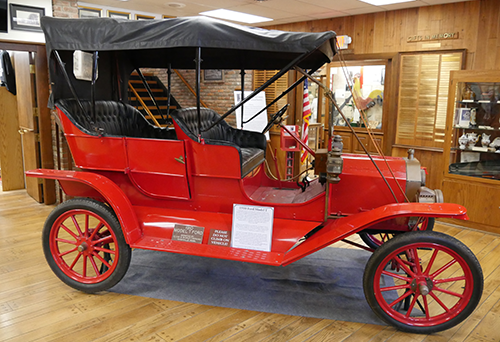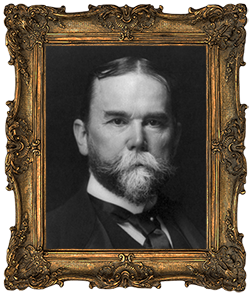The Fable of the Flivver at the John Hay Center

Through a recent rotation of display items, our impressive 1910 Model T has made a durable return to the interior of the Stevens Museum, and is now sitting ‘pretty’ in the main entrance foyer. After several years in the Agricultural Barn, the “Flivver” has returned to a more dignified location and upon reopening, patrons will soon be able to see the extraordinary vehicle up close.
Our historical society was extraordinarily fortunate enough to receive this significant, old piece of automotive history, from county native, Shirley Clipp Perkins, in 1997. When Shirley’s father passed away in the summer of 1996, she inherited his fully-restored Ford Model T Touring car, but the family was unsure of what to do with the beautiful antiquity. Shirley, (then living in Nashville, TN.), reached out to former WCHS President, Willie Harlen, to gauge his interest in receiving the automobile, as a donation. Excitedly, Mr. Harlen immediately responded in the affirmative, but stipulated that he would have to find a safe place for it’s display, before he could accept the vehicle.
More than a year later, (or the approximate equivalent of over 950 round-trips between Nashville and Salem, in the Model T itself!), Mr. Harlen managed to muster the proper motivation, in a small group of volunteers, to retrieve and transport the cherished acquisition to the John Hay Center. Thankfully, the Perkins family was of patient stock and graciously followed through with the benevolent transaction. The Model T resided in the Stevens Museum foyer for years, then was later relocated to the Agricultural Barn. For the youth of today, the agricultural display might seem like an odd place to exhibit a car. But, not so, for the Model T. During the vehicle’s heyday, agriculture was the occupation of a great many people. Outside of commercial industry, there was very little available, to the mass public, in the way of power sources and tools. A cognizant Henry Ford, applied these contemporary realities, while overseeing the designs and requirements of the Model T.
Consequently and intentionally, Henry’s outlines for the Model T were almost as much for a tractor and/or portable engine, as they were for an automobile. The finished product was always well regarded for its all-terrain abilities and ruggedness. It could travel a rocky, muddy farm lane, cross a shallow stream, climb a steep hill, and be parked on the other side to have one of its wheels removed and a pulley fastened to the hub for a flat belt to drive a bucksaw, thresher, silo blower, conveyor for filling corn cribs or haylofts, baler, water pump, electrical generator, and many other applications.
Since being pushed back into the Stevens Museum, (by a group of volunteers, during the first week of November), our flivver has been receiving some much needed TLC and low-level maintenance to brighten it’s appearance and overall disposition. The somewhat tedious task of cleaning, polishing and conditioning has helped to expunge a large part of the discount the vehicle received from years of relegation in our primary Agricultural exhibit.
Recently, all of the revived attention seems to have caused a shift, in the cosmic atmosphere, surrounding our Model T. Because, even though, our most gracious donor, Mrs. Shirley Clipp Perkins, sadly passed away in 2017, during the first week of December, we received a phone message from Mr. Clyde Perkins, her surviving husband. He stated that he had hoped to speak with someone about the possibilities of moving his father-in-law’s donated car back indoors from the Agricultural Barn. He said, during their last visit, the family was somewhat disappointed to see where we had elected to display the old vehicle. Therefore, he was prepared to beg, plead and/or petition whomever he had to, in order to convince someone to reposition the car indoors.
Since then, we have been trying endlessly to return Mr. Perkins phone call, to delight him with the news that his campaign is unnecessary. But thus far, we have been unsuccessful in reaching him. Which is unfortunate, because I was full of questions about the car’s specific history for this article.
Our efforts are ongoing.
By: Jeremy Elliott, JHC Executive Director 2020


